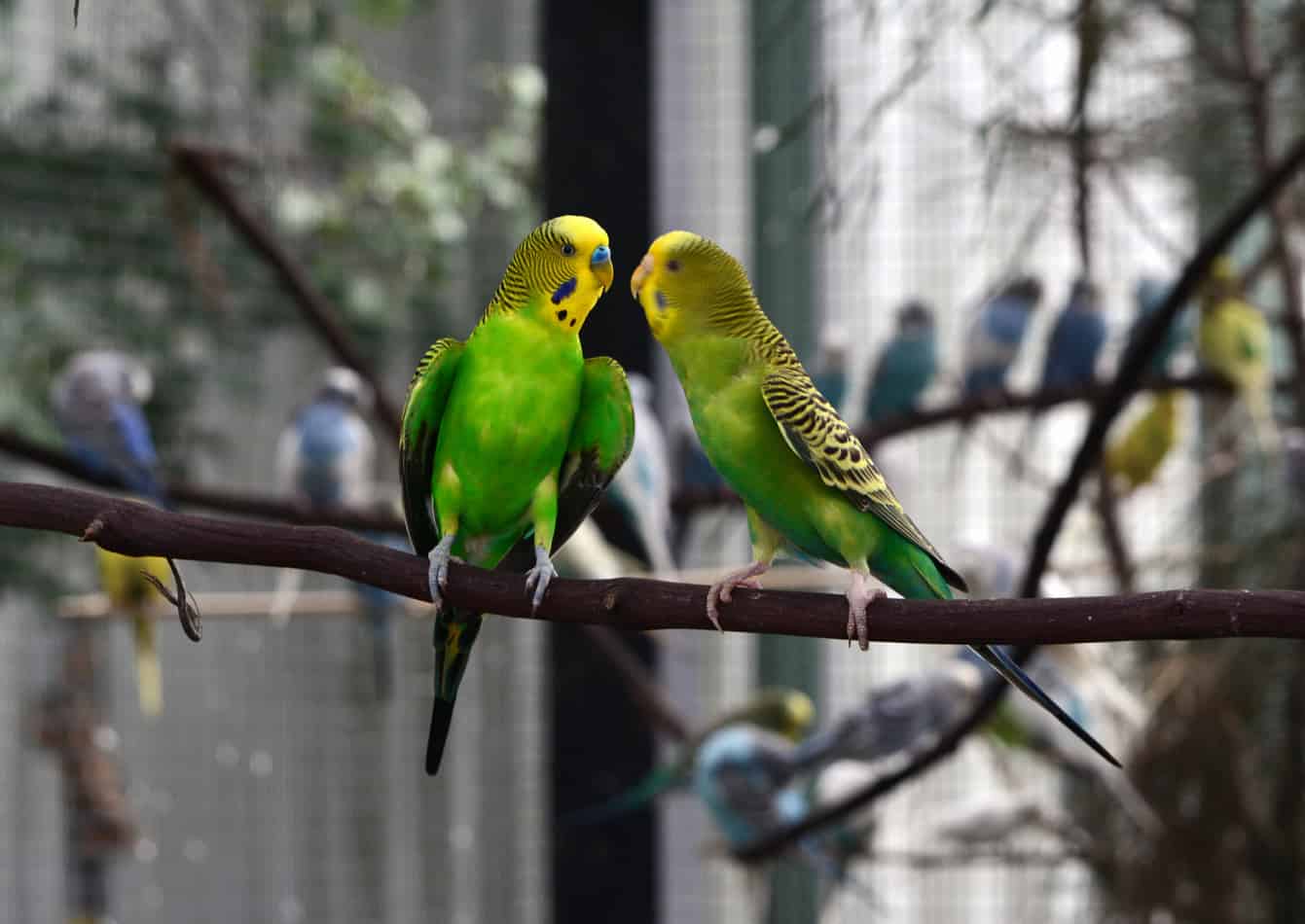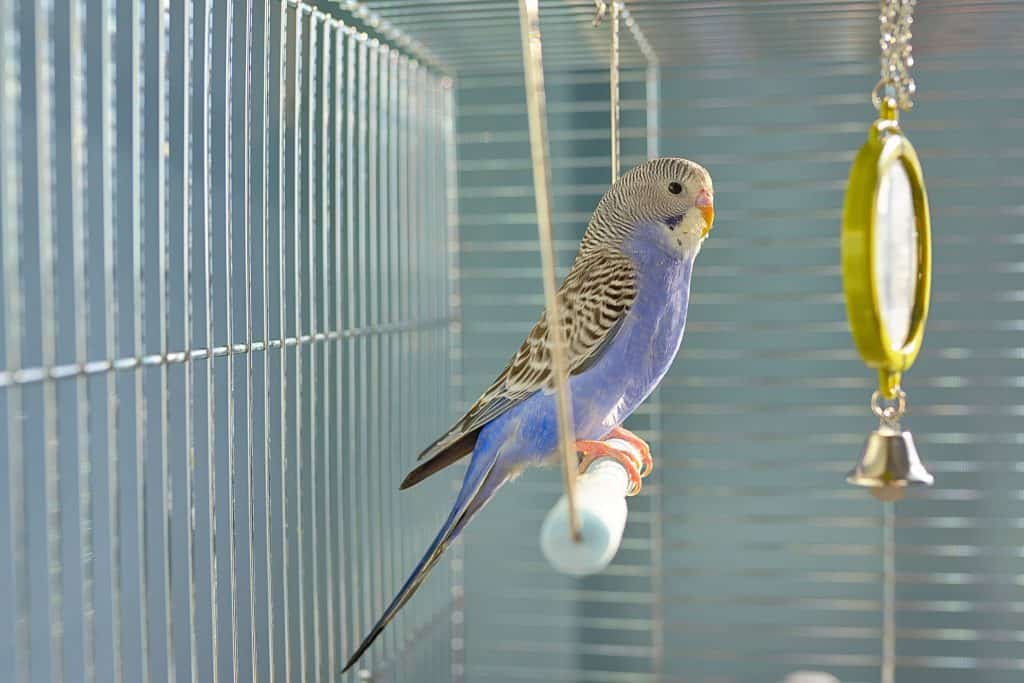How Long Do Parakeets Live on Average?

Now that you have a parakeet, you’re going to have to know a lot about them to make sure that they live as long as they can. But to give them the best care you can, you’ll want to know what their average lifespan is.
How long do parakeets live on average? Parakeets live an average of 15 years, but it really depends on the species. Parakeets cal live anywhere from about 5 to 20 years.
There are three different species of parakeets and here are their lifespans:
- The budgerigar parakeet lives an average of 5 to 10 years
- The monk parakeet lives an average of 15 to 20 years
- The plain parakeet lives an average of 15 years
Now that you know how long each species of parakeets lives, you need to know how to take care of them to make sure that they meet and even exceed that expectancy. In this article, I am going to talk about how to care for your parakeet, what to feed them, how to house them, and what to do if they get sick.
Caring for Your Parakeet
In order for your parakeet to live as long as possible, you have to know how to take care of it properly. Budgerigar, or budgie, parakeets are the most common parakeets to keep as pets, and perhaps the most common bird to keep as a pet in general.
MY LATEST VIDEOS
The Cage
The first step to keeping a healthy parakeet is to prepare its cage the correct way. Buy a big cage, bigger than you think that you need. Your parakeet needs to be able to stretch its wings, play, and even fly around a little bit in the cage.
The cage should not be circular or the budgie will not be able to spread their wings. It should be wider at the top than it is on the bottom and it should have a square top.
You may be tempted to buy a cage with a fancy and pretty top, but you need to stop yourself. It may look pretty, but those cages are not good for your parakeet. Birds like quails will fly in a verticle pattern, but birds like budgie parakeets will fly in a horizontal pattern which means that they want as much space horizontally as possible.
Buying a cage with a fancy and pinched top is a waste of space and money.
You need to make sure that the cage that you pick is easy for you to clean. Make sure that you can get your hand in and out of the cage easily. The bottom of the cage should slide out so you can empty it regularly. You should be able to easily change out and clean the feeding bowl and water dispenser.
Buy a cage that allows a lot of light in. It needs to be big enough that you can put a few toys and perches without crowding your budgie. Budgies are very active and can’t feel crowded.
You should only have two budgies per cage (unless, of course, you have a cage the size of a small room, then you can have more than two I guess).
Have a feeding dish and a water dispenser easily accessible to you and to your budgie in the cage.
Having a happy and healthy parakeet is essential to helping it live the longest that it can. As long as you give them enough room to exercise and fly around, you can significantly increase their lifespan. Keeping them in a clean environment is essential as well because your bird can’t be healthy if their cage is not.
Toys and Perches
Pick two or three toys to put in the cage for one budgie and have quite a few perches set at different heights around the cage. Toys provide stimulation for your budgie. If they get bored, they can start plucking their own feathers out. The best toys usually have balls, ropes, and/or bells.
For perches, it is best to pick perches that are natural. Try to find a perch made of eucalyptus wood. Avoid perches made from prunus trees (because they contain cyanogenic glycosides, which can harm your bird) and perches made from oak wood (because they contain tannins, which can also be detrimental to your budgie’s health).
If you pick the wrong kind of perches, you could end up causing harm to your budgie, and you want to make sure they live as long as possible.
The perches need to be stable and set at many different heights, as well as spaced around the cage. Your budgie will want to fly around and play, so they need enough in their cage to stimulate and entertain them. Again, it is important to give your budgie a cage that they can exercise in so they can live a long and healthy life.
There is some controversy around including a mirror in your budgie parakeet’s cage. Budgies do tend to find lots and lots of entertainment just talking and looking at themselves for hours on end. However, there have been studies that might show a link between single budgies with mirrors and psychological damages.
Because budgies are very social, they can get lonely if all they have to talk to is a reflection of themselves. Having a mirror in your budgie’s cage can also lead to crop infections in your bird.
Birds like to regurgitate food for their mates (don’t ask me why I have no idea why), but the mirror bird will not return their affections. Obviously, if you want your budgie to live as long as possible, crop infections are not ideal.
If you pay enough attention to your budgie, they should be just fine. If you do want to put a mirror in their cage, make sure it is securely attached to prevent your bird from hurting itself.
You could also consider getting a second budgie to accompany your first one in its cage so it can be social with an actual bird instead of a reflection. Budgies do live longer if they have more social interaction.
This social interaction can come in the form of contact with you, but it is best if they have a budgie companion as well.
Environment

Put your budgie’s cage in a warm room with lots of light. Don’t put the cage next to a sunny window, as the prolonged exposure to the heat could harm the budgie. Also, avoid placing the cage near an open door or a door that opens and closes often.
The cold draft can also harm your bird. Sunlight is important for keeping your budgie healthy, but we all know that too much of a good thing can still be harmful.
Clean out the cage once a week. The easiest way I’ve found to clean a bird cage is to layer the bottom with newspaper and then just pull out the newspaper and replace it when the time comes. Keeping a clean cage is paramount if you want to extend the lifespan of your budgie.
Budgies will poop every 15 minutes or so, so you really need to clean the cage once a week (or more often if you find it necessary in order to keep your bird happy and healthy)
When you clean the floor of the cage, use only mild dish soap and water. If you use other chemicals or cleaning products, you could risk harming your budgie.
Another thing to include in your budgie’s cage is a bird shower. Budgie parakeets like to clean themselves, splash around, and even go unde the water occasionally for fun. Make sure to change out the water often and be sure to never fill the bath too full or your budgie could make a mess.
You could also spray down your budgie with Bird Spray every now and then to clean them and cool them off. It can be a fun game to play with your budgie. You can find some here on Amazon.com for around $10.
When it comes time for your bird to sleep (or when it is going to be loud in your house), drape a towel or blanket over the cage. This will keep your budgie in a darker area and block out some of the sounds. Make sure that your budgie will still get enough air.
One way to do this is to leave the back end of the cage uncovered. The towel or blanket should be made out of material that your bird can’t catch their claws on.
If your budgie is afraid fo the dark (yes, that can happen and yes, they will let you know), then you can put a nightlight near, on, or in their cage. Don’t let your budgie panic because they could fly around frantically and end up hurting themselves or their cage-mates.
Including the Family
You need to name your budgie and use that name often, especially when you are feeding them. This will make them more familiar and comfortable with you. After all, you can’t eat when you’re uncomfortable.
Introduce your family and your house gradually to your budgie. Have you family meet your bird one at a time. Have them feed your budgie and call the parakeet by name. If you have other pets, make sure they do not harm your bird. Watch small children when they handle the parakeet.
You need to treat your budgie parakeet with love and kindness. Be sure to be gentle, as you stronger than you think and you can end up harming your fragile bird if you are not careful.
Even though you are going to want to, do not kiss you budgie, and make sure you tell anyone that will be handling your budgie not to kiss them. Human saliva is actually toxic to budgies and can carry diseases that will be detrimental to your bird. Kissing your budgie can actually shorten their lifespan.
Talk to and play with your budgie often. They need to know that you love them and they need to associate good memories with you. They are social animals and they will love getting to know you. Once they are comfortable with you, they will play with you for hours.
You can also feed your budgie parakeet by hand. Dip your finger in water and then in seeds so the seeds stick to your finger and then hold your finger up to your budgie so they can nibble. You can also hold your parakeet in one hand and hold a larger food (like a banana) in the other and let them nibble and peck.
Once your parakeet is comfortable and used to your house, you should let them outside of their cage to fly around (careful though, remember they poop every 15 minutes).
Close all of the doors and windows and make sure the cat is out of the room. Stay in the room to supervise and let your budgie fly around for a bit.
Once it’s time to call your budgie back to their cage, create only one light source, like one window, and stand by it. Your budgie will be attracted to the light and you can act as the perch they will naturally fly to. Gently place them back in their cage and make sure it is latched tight.
Your Parakeet’s Diet

The go-to food for pet birds is bird seed, but really bird seed should only be about one-sixth of your budgie’s diet. Don’t let your budgie fill up on seeds because it could shorten their life span.
Birdseed alone does not offer all of the nutrients that your budgie needs to be healthy. Too much birdseed could lead to cancer, obesity, and other health problems in your bird.
The rest of your budgie’s diet should include fruits and veggies (mostly dark green or yellow colored), boiled eggs and shredded cheese, and additional minerals like cuttlebones or mineral blocks.
Fruits you can feed your budgie include:
- Apples
- Grapes
- Mangos
- Bananas
Vegetables you can feed you budgie include:
- Pumpkin
- Carrots
- Parsely
- Broccoli
- Sweet potato
- Squash
- Spinach
Make sure all the additional food you feed your budgie is raw (except for the boiled egg). Cooking the food can take away some of the important nutrients.
The variety is really good for your budgie, but you need to make sure that you limit the treats, feeding them no more than a one-half teaspoon at a time.
If you chose to give your budgie a cuttlebone or mineral block, make sure it securely fastened to the side of the cage with the soft side facing your bird so they can scratch at it.
Your budgie should eat seeds and pellets every day; fruits, veggies, and soft foods every other day; and boiled eggs and shredded cheese once a week.
If your budgie won’t eat, then try chopping up raw fruits and veggies and placing them in an empty feed cup. If you want to introduce something new into their diet, do it gradually.
Be sure that your budgie can easily access their food and water at all times. They know how much to eat and drink. If your budgie does not or cannot eat for 24 hours, they can get really sick.
Change out and clean the water dispenser daily. Only clean the dispenser with water and vinegar because other products in your budgie’s water could harm them. The vinegar will prevent bacteria growth in the water dispenser.
The water and the food should be next to each other so that your budgie can eat and drink at the same time. The feed cup should not be too deep so that your budgie doesn’t have to dig to get to their food.
What to Do if Your Parakeet Gets Sick
You should take your budgie parakeet to the vet for a check-up at least once a year. If your bird starts exhibiting symptoms that make you suspect that they are sick, take them to the vet immediately. Better safe than sorry.
Common symtoms include:
- Abnormal breathing
- Discharge from eyes or beak
- Mucus on feathers
- Abnormal behavior
- Loss of weight
- Obesity (losing the streamlined look or becoming lethargic)
Always make sure that your budgie has enough room to exercise, is allowed to be social enough, and is eating the right diet (with proper variety), and your bird should live a long and happy life.
Related Questions:
How can you tell when your parakeet is an adult? When parakeets are babies, they have pure black eyes. This usually lasts around four months. After four months, the iris start to fade to a light gray or brown. This stops by the time they are eight months old, at which point they are adults.
Do parakeets live longer in captivity? The only place you will see parakeets naturally in the wild is in Austalia. In captivity, parakeets can live up to 20 years, but in the wild, they live shorter life spans. This is mainly due to predators, inconsistent food, and exposure.
